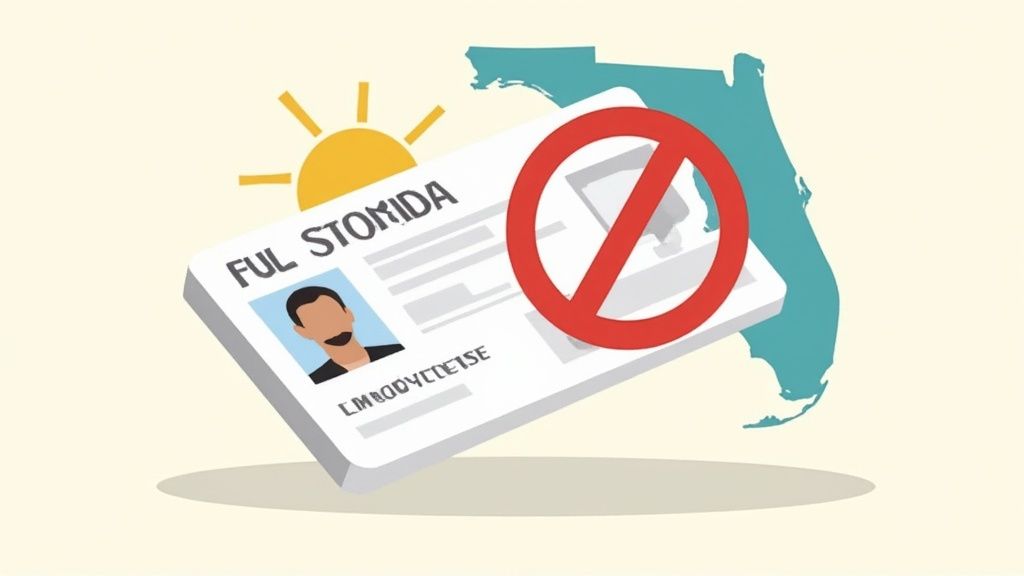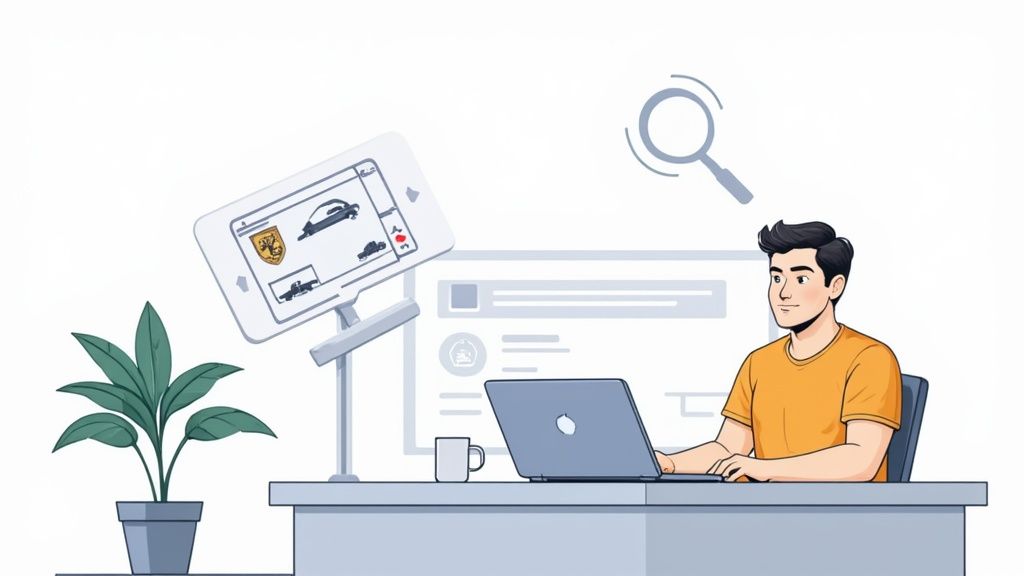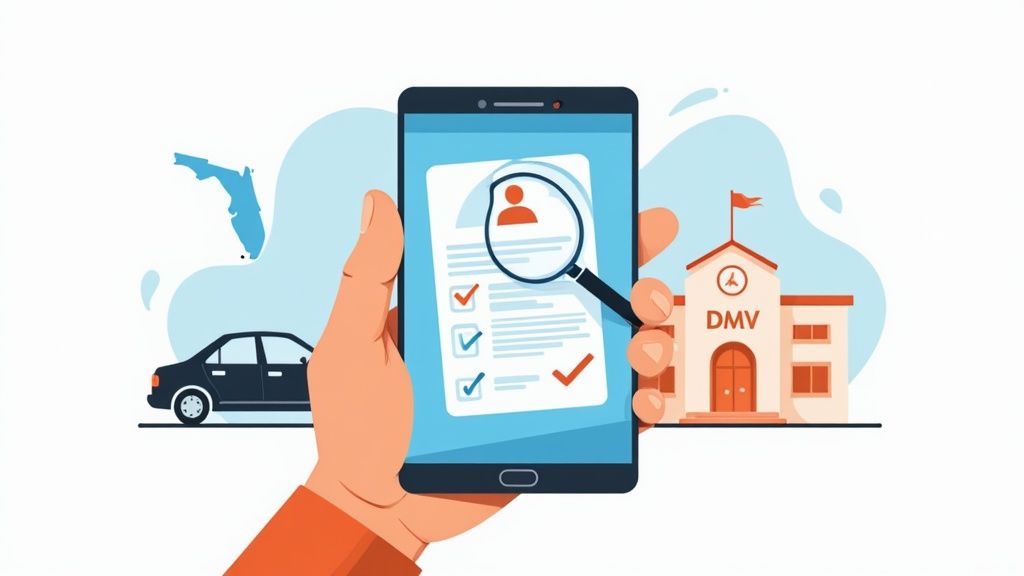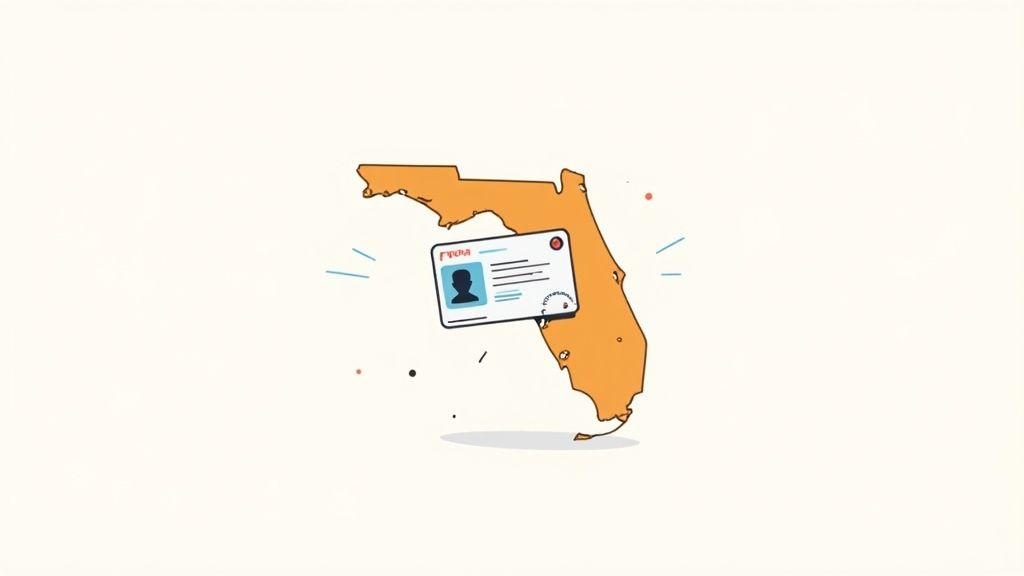Let’s be real—nobody ever plans on getting a speeding ticket. But understanding why it happens is the first real step to making sure it doesn’t happen again. It usually comes down to subtle things: the pressure to keep up with everyone else on the highway, or just how quiet and smooth new cars are, making 80 mph feel like 60.
Once you can spot these common traps, you’re in a much better position to avoid seeing those blue and red lights in your rearview mirror.
Why Florida Drivers Get Speeding Tickets

Sure, the easy answer is just “driving too fast.” But anyone who drives in Florida knows it’s a bit more complicated than that. Most of us aren’t intentionally trying to break the law. Instead, we fall into traps that are almost unique to the driving conditions here.
The idea isn’t to make excuses. It’s to get inside the psychology of speeding so you can recognize the signs and steer clear of a ticket. This kind of awareness is your best defense.
The Flow of Traffic Illusion
“I was just keeping up with traffic!” It’s probably the most common reason people give for speeding, and it feels right, doesn’t it? When you’re on a busy stretch of I-95 or the Turnpike and you’re the only one doing the posted 70 mph, it can feel like you’re a hazard. The pressure to match the pace of the cars whipping by you at 80 or 85 mph is intense.
Here’s the problem: that feeling is an illusion. Law enforcement officers are pros at picking one car out of a pack, and telling a judge “everyone else was doing it” will get you nowhere. The only thing that legally protects you is the posted speed limit.
Key Takeaway: The “flow of traffic” is a social pressure, not a legal shield. Sticking to the posted speed limit is the only way to ensure you aren’t the one singled out for a citation.
Modern Cars and Speed Creep
Cars today are incredible. They’re built for comfort, with cabins so quiet and rides so smooth that your sense of speed gets completely distorted. That old rumble you’d feel at 70 mph in a car from 20 years ago? It’s gone. In a new vehicle, 70 can feel more like 55.
This is a classic case of speed creep, where you gradually and unconsciously press the accelerator without even noticing. It’s a huge reason for tickets on those long, straight stretches of Florida highway where your mind starts to wander.
The High Stakes of Being Late
We’ve all been there. You’re running late for a big meeting, trying to catch a flight out of MCO, or scrambling to pick up the kids on time. Your brain switches from “safety first” to “I have to get there now.”
First, you push the limit by 5 mph. Then 10. Before you know it, you’re going 15 over, hoping to shave off a few precious minutes. This is a recipe for a ticket and, more importantly, a major safety risk. Those few minutes you might save just aren’t worth the fine, the points on your license, or a potential accident.
And the consequences are serious. In 2023, speeding was a factor in a staggering 29% of all traffic fatalities nationwide, resulting in 11,775 deaths. These aren’t just statistics; they’re a stark reminder that speed limits are about saving lives. To get a full breakdown of the rules of the road, check out our guide on Florida speed limit laws.
Proactive Driving Habits to Stay Under the Limit

Knowing where the speed traps are is one thing, but actually changing how you drive is what keeps you ticket-free. The real trick is building good habits so that driving at a safe, legal speed feels completely natural, not like you’re fighting the urge to floor it.
These aren’t just generic tips you’ve heard a dozen times. They’re practical, real-world techniques that work on Florida’s busy roads. By making a few small, consistent adjustments, you can make safe speeds your default setting.
Master Your Following Distance
Tailgating is a fast track to a speeding ticket. When you’re glued to the bumper of the car ahead, you’re forced to mirror their every move. If they suddenly punch it to pass someone, your own foot instinctively follows suit, and suddenly you’re doing 15 over without even realizing it.
The best defense is the three-second rule. It’s simple. Pick a fixed object up ahead—a highway sign, a bridge, anything easy to spot. As the car in front of you passes it, start counting: “one-one-thousand, two-one-thousand, three-one-thousand.” If you reach that same object before you finish the count, you’re way too close.
Creating this buffer of space changes everything. It gives you room to breathe and react calmly, leading to smoother braking and acceleration. You’ll not only avoid reactionary speeding but also save on gas and feel a lot less stressed.
This habit is a cornerstone of smart driving. If you want to explore more strategies like this, there’s a whole world of defensive driving techniques that can sharpen your awareness on the road.
Use Cruise Control Intelligently
Ever driven down a long, flat stretch of I-75 or the Turnpike? It’s dangerously easy for your speed to creep up when the scenery never changes. Before you know it, your foot gets a little heavier, and you’re cruising at ticket-worthy speeds. This is exactly what cruise control was made for.
Setting your cruise control right at the speed limit (or a mile or two under) is one of the most effective ways to prevent speeding on a long haul. It takes the mental effort out of maintaining your speed, letting you focus completely on your surroundings.
But remember, cruise control isn’t an autopilot. You have to be smart about when you use it.
- When to Use It: It’s perfect for highways with light-to-moderate traffic in clear, dry weather.
- When to Turn It Off: Never use cruise control in heavy rain or on slick roads, as it significantly increases the risk of hydroplaning. It’s also useless in the stop-and-go mess of rush hour traffic.
Build Mental Checkpoints
Ultimately, your best tool for avoiding tickets is your own brain. You can develop simple mental habits that are more reliable than any gadget.
A great one is to create a “scan pattern.” Every time you glance at your rearview or side mirrors, make it a habit to also flick your eyes down to the speedometer. By linking these two actions, checking your speed becomes an automatic reflex.
Another powerful tactic is to scout your route ahead of time. If you have an important meeting, pull up the route on Google Maps or Waze the night before. See if there’s construction or typical traffic jams. Giving yourself an extra 15 minutes of buffer time completely removes the stress and frantic speeding that comes from being late.
A Quick Mental Checklist to Avoid Speeding:
- Pad Your Travel Time: Always give yourself an extra 15-20 minutes for any trip. You’ll be amazed at how much calmer you feel.
- The Mirror-Speedometer Glance: Tie them together. Every time you check a mirror, you check your speed. No exceptions.
- Keep a Cool Head: If you feel yourself getting angry or stressed by other drivers, just take a few deep breaths. A calm driver is a safe, ticket-free driver.
Understanding Modern Speed Enforcement Technology
If you think spotting a police cruiser on the horizon is enough to avoid a speeding ticket, it’s time for a reality check. That strategy is a relic from a different era. Today, law enforcement has an arsenal of high-tech tools that have completely changed the game from simple observation to laser-focused precision.
The point of understanding this technology isn’t to figure out how to beat it—it’s to realize why your best (and only) defense is to drive safely and consistently. These systems are accurate, fast, and incredibly hard to argue with in court.
The Shift From Radar To LIDAR
For years, radar (Radio Detection and Ranging) was the gold standard. It sends out a wide radio wave that bounces off your car to measure its speed. It works, but it has a major drawback: that wide beam can make it difficult to single out one car in a pack of traffic.
That’s why many agencies have upgraded to LIDAR (Light Detection and Ranging). Instead of a broad radio wave, LIDAR uses a concentrated beam of infrared light. Picture the difference between a floodlight and a laser pointer.
- Pinpoint Accuracy: A LIDAR gun can target your license plate from over half a mile away, instantly killing the old “it must have been the other guy” excuse.
- Instant Readings: It gets a speed reading in under half a second. That’s often faster than a radar detector can even give you a warning.
This incredible precision is why LIDAR is now the go-to tool for a lot of Florida law enforcement, especially on busy highways where they need to isolate a specific vehicle.
Common Speed Enforcement Technologies Explained
To give you a clearer picture, it helps to break down the different technologies officers might be using on any given day. Each has its own method of operation and strengths.
| Technology Type | How It Works | Effective Range | Key Driver Takeaway |
|---|---|---|---|
| Radar | Emits a broad radio wave that bounces off a moving vehicle to calculate speed using the Doppler effect. | Up to 1 mile | Prone to picking up the largest, fastest object in its wide beam. Less precise in heavy traffic. |
| LIDAR | Shoots a narrow beam of infrared light that reflects off a specific point on a vehicle to measure speed. | Up to 4,000 feet | Extremely accurate and fast. Can single out one car in a group, making it very difficult to contest the reading. |
| Pacing | An officer matches your speed in their patrol car and uses their own calibrated speedometer to clock you. | Variable | Requires the officer to maintain a consistent distance. Your best defense is being aware of your surroundings. |
| VASCAR | An officer manually times your vehicle as it passes between two fixed points (e.g., lines on the road). | Pre-measured | Relies on human timing, introducing a small margin for error, but still a legally accepted method of enforcement. |
Knowing the differences makes one thing clear: there’s no single trick to avoid detection. The only consistent strategy is managing your speed.
Automated Enforcement Is Always Watching
Beyond the tools an officer holds, automated systems are now a constant presence. These cameras are on the job 24/7, and they never take a break.
This trend is only growing. For instance, in 2025, Western Australia is deploying AI-powered cameras that can spot speeding, illegal phone use, and seatbelt violations all at once. According to a post on AI’s role in automated speed enforcement from elovate.com, these systems use machine learning to get more accurate over time.
The infographic below shows a simple truth: the faster you go, the higher your odds of getting a ticket.
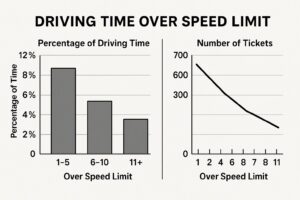
It’s clear that while plenty of drivers creep a few miles over the limit, the ticket risk skyrockets with every additional MPH.
And it’s not just about speed. Many Florida drivers are already familiar with red-light cameras, which work on the same automated principle. You can get the full rundown on how a red light camera in Florida operates and what your options are if you get a ticket.
The Unblinking Eye: Automated cameras don’t get tired, they don’t get distracted, and they don’t give warnings. They enforce the law consistently, making adherence the only guaranteed way to avoid a penalty.
Once you understand this technology, you realize that avoiding a ticket isn’t about luck anymore. It’s not about hoping you don’t see a patrol car. It’s about driving in a way that makes you invisible to these systems. Sticking to the speed limit is the one tactic that defeats every single one of them, every time.
Using Technology as Your Co-Pilot
Let’s be honest, modern cars come with a lot of bells and whistles, and your smartphone is more powerful than the computers that sent us to the moon. Why not put that technology to work for you as a digital co-pilot? This isn’t about trying to outsmart the police; it’s about using the tools you already have to be a more aware and informed driver.
From the apps on your phone to the safety features built right into your car, you have an incredible number of resources at your fingertips. Used correctly, they can act as a constant, gentle reminder to keep your speed in check and your driving record clean.
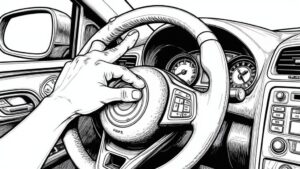
Navigation Apps The Smart Way
Most of us already use apps like Waze or Google Maps for directions, but they offer powerful features that can help you avoid a ticket.
- Real-Time Speed Limit Display: This is a game-changer. Both apps can show the current speed limit right on your screen. It’s an easy, at-a-glance way to confirm you’re not accidentally speeding, especially in unfamiliar areas where speed limits can change without much warning.
- User-Reported Alerts: Waze is famous for its community-based alerts for police presence. While helpful, treat these as a reminder to check your speed, not a get-out-of-jail-free card. An officer could set up shop long before anyone reports them.
Pro Tip: Dive into your app’s settings and turn on audible speed alerts. You can usually set it to beep when you go a few miles per hour over the limit. That simple sound is often all it takes to get you to ease off the gas.
A Word on Radar Detectors in Florida
Some drivers swear by dedicated radar detectors. Before you run out and buy one, it’s crucial to understand what they do, what they don’t do, and the law here in Florida.
The good news is that radar detectors are legal in passenger cars in Florida. The catch? They are illegal in commercial vehicles and on all military bases.
A quality detector can alert you to police radar bands (K, Ka, etc.). But here’s the reality: they are far less effective against “instant-on” radar and completely useless against laser (LIDAR). A LIDAR alert just means your speed has already been recorded. So, while it might offer some warning, it’s not an invisible shield.
Your Car’s Built-In Safety Features
Don’t overlook the tech that came with your car. Many newer vehicles are packed with intelligent systems designed to help you drive safer and, by extension, avoid tickets.
- Adaptive Cruise Control (ACC): This isn’t your grandpa’s cruise control. ACC uses sensors to automatically keep a safe distance from the car ahead, slowing down and speeding up with traffic. It’s a fantastic tool for preventing that unintentional speed creep on the highway.
- Intelligent Speed Assistance (ISA): A more advanced feature, ISA uses cameras and GPS to actually read speed limit signs. Depending on the system, it might give you an alert or even actively limit your car’s top speed to the posted limit.
These systems are part of a larger trend toward automated safety. Automated speed cameras have been around since 1987, and as of January 2022, they were being used in 171 communities across the country. They are often placed in areas where a traditional traffic stop isn’t safe or practical. You can explore the history and expansion of automated enforcement on the CDC’s transportation safety page. This shift makes it more important than ever to use your car’s own technology to stay on the right side of the law.
What to Do When You Get a Florida Speeding Ticket
Even with the best intentions, those flashing blue and red lights can still appear in your rearview mirror. It happens. When it does, your focus needs to shift instantly from prevention to damage control. The key is to take a breath and understand your options, because the decisions you make next will have a big impact on your driving record and your bank account.
The absolute worst thing you can do is give in to the frustration and just pay the fine online. In Florida, paying that fine is the same as pleading guilty. The state automatically adds points to your license, and those points are exactly what insurance companies look for when it’s time to jack up your rates.
You Have Three Choices—Choose Wisely
After a Florida officer hands you a non-criminal speeding ticket, you’re at a crossroads. You essentially have three ways to handle it, and each path leads to a very different outcome.
- Pay the Ticket: This feels like the easiest route, but it’s a trap. Paying the fine is an admission of guilt, points go on your record, and your insurance company will likely raise your rates for years.
- Fight It in Court: You can plead not guilty and argue your case before a judge. This can be a gamble, and it often means hiring a traffic attorney to have a real shot at winning.
- Elect to Attend Traffic School: For most drivers, this is the golden ticket. If you’re eligible, you can complete a state-approved Basic Driver Improvement (BDI) course to keep the ticket off your record.
This third option is a lifesaver for Florida drivers. By choosing traffic school, you stop the points before they ever get added to your license.
Key Takeaway: When you complete a BDI course for a Florida ticket, no points are assessed for that violation. If there are no points, your insurance company is never notified, and they can’t raise your rates.
Why a BDI Course Is Your Best Defense
Let’s dig into why electing to take a Basic Driver Improvement course is such a smart move. It all comes down to protecting your driving record. In Florida, accumulating just 12 points in 12 months triggers an automatic license suspension.
Opting for traffic school neutralizes the most damaging part of the ticket. You’ll still need to pay the court fees for the citation itself, but you sidestep the two costliest consequences:
- No Points on Your License: This keeps your record clean and protects you from a potential suspension.
- No Insurance Hikes: Since the violation isn’t reported to your insurer, you avoid what could amount to hundreds or even thousands of dollars in increased premiums over the next three to five years.
The process is pretty simple. When you go to pay the citation, you must tell the Clerk of Court in the county where you got the ticket that you are “electing” to take a BDI course. From there, you’ll typically have 60 to 90 days to finish the course and send them your completion certificate.
Are You Eligible for Traffic School?
While it’s an incredible option, it’s not available to everyone for every ticket. Florida has rules in place to make sure drivers use this privilege responsibly.
You are probably eligible if:
- You hold a standard, non-commercial Florida driver’s license.
- You haven’t taken a BDI course in the past 12 months.
- You haven’t used the BDI option more than five times in your entire life.
The ticket must also be for a non-criminal moving violation. For example, you can’t use traffic school for major offenses like reckless driving or for being clocked at more than 30 mph over the speed limit. For a deeper dive into the specifics, check out our complete guide on how to dismiss a speeding ticket and keep your record clean.
The best part is that modern BDI courses are online and designed for real life. You can work through the material at your own pace, on your own schedule, from a phone or computer. It turns a stressful mistake into a simple task that saves you a ton of money and headaches down the road.
Florida Speeding Tickets: Your Questions Answered
Even with the best advice, getting a speeding ticket can leave you with a lot of questions. Florida’s traffic laws can be a bit tricky, and it’s easy to get tangled up in the details about points, insurance, and what you should do next. Let’s clear the air and tackle some of the most common things drivers worry about after seeing those flashing lights.
Think of this as your go-to guide for the stuff that really matters. Understanding exactly what’s at stake is often the best motivation for driving smarter in the first place.
How Many Points Is a Florida Speeding Ticket?
The number of points a ticket adds to your license comes down to one thing: how fast you were going. The system is set up to be tougher on higher speeds, and those points are what really cause the long-term headaches with insurance and potential license suspensions.
Here’s the breakdown for a typical speeding violation:
- Less than 15 mph over the limit: This nets you 3 points on your driving record.
- 15 mph or more over the limit: This is a more serious offense and will cost you 4 points.
- Speeding that leads to a crash: This also adds 4 points, no matter the speed.
It’s important to know that points add up fast. If you get 12 points within a 12-month period, you’re looking at a 30-day license suspension. This is precisely why the traffic school option is such a lifesaver—it stops those points from ever touching your record.
Can I Just Take Traffic School to Make It Go Away?
Not always. While it’s a fantastic option, traffic school isn’t a free pass for every situation. Florida has some specific rules to make sure drivers don’t abuse the system. Think of it as a privilege for a minor mistake, not a right.
To elect a Basic Driver Improvement (BDI) course and keep the points off your record, you generally need to meet these conditions:
- You have a standard Class E driver’s license (not a commercial license).
- You haven’t taken a BDI course in the last 12 months.
- You haven’t used the traffic school option more than five times in your life.
One critical exception: criminal speeding. If you’re caught driving 30 mph or more over the limit, you can’t just opt for traffic school. That kind of violation usually means a mandatory court date. The same goes for commercial (CDL) drivers—they aren’t eligible to take BDI school to wipe away points.
Will My Insurance Really Go Up After Just One Ticket?
If the points stick, then yes, almost certainly. Insurance companies see points on your record as a big red flag. From their perspective, a driver with a violation is statistically more likely to get into an accident, and they’ll adjust your premium to cover that perceived risk.
The fine you pay at the courthouse is often just the beginning. The real financial pain comes from the insurance surcharge, which can easily cost you hundreds, if not thousands, of dollars over the next three to five years.
This is where BDI school truly shines. When you complete the course, the state officially withholds the points for that ticket. Your insurance company is never notified, and if they don’t know about it, they can’t raise your rates. Avoiding that rate hike is hands-down the biggest financial win of choosing traffic school.
How Does an Online BDI Course Actually Work?
The whole process is built around convenience. Forget stuffy classrooms and awkward weekend schedules. Modern, state-approved BDI courses are 100% online, so you can knock them out whenever you have the time.
After you’ve paid your fine and told the Clerk of Court you’re electing traffic school, the rest is a breeze. You just sign up for a state-approved online course and work through the material on your own time, whether it’s on a laptop, tablet, or even your phone.
The course itself is a great refresher on Florida traffic laws and defensive driving skills—the very things that help you learn how to avoid speeding tickets down the road. Once you pass the final exam, your completion certificate is automatically filed with the state for you. The court gets it, processes it, and just like that, the points are officially kept off your record.
A single ticket doesn’t have to haunt your driving record for years. By electing to take a state-approved course from BDISchool, you take control of the situation, prevent points, and stop insurance hikes before they start. Our fully online, self-paced course makes it easy to meet court requirements on your schedule. Enroll today and protect your record.
